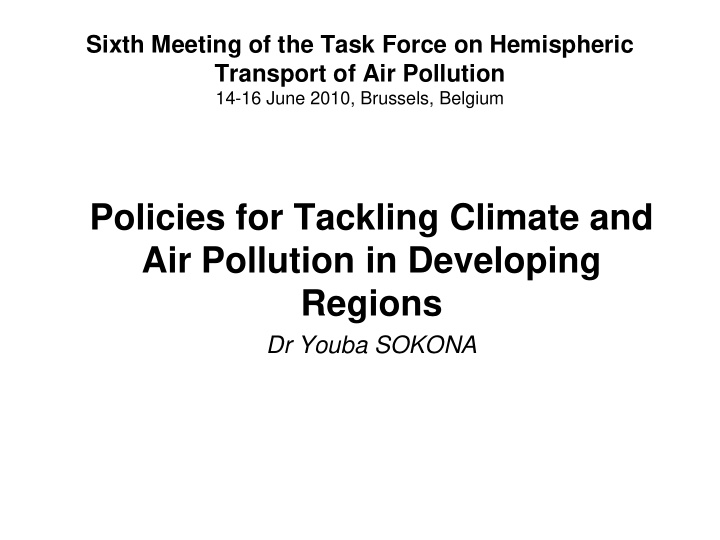



Sixth Meeting of the Task Force on Hemispheric Transport of Air Pollution 14-16 June 2010, Brussels, Belgium Policies for Tackling Climate and Air Pollution in Developing Regions Dr Youba SOKONA
Observations • Air pollution and climate change are intertwined with co-benefits and trade-offs • They both have two ways relationship with development pathways • The two problems have so far been mainly addressed by separate policies and not fully integrated into development policies • Energy is a key driver of climate change and air pollution
Key messages 1. Benefits of integrating development, air quality and climate policies have been demonstrated 2. The national policy level is crucial for implementing integrated development, air quality and climate policies 3. There is a need to enhance the impact of national experiences by widely replicating promising approaches • with assistance from international organisations, and • by aiming at development activities that have a large influence on global GHG emissions and air quality 4. Mainstreaming climate change and air pollution in international policy frameworks and agreements is not done widely enough..
Which approach to motivate DCs? • Climate change and air pollution = threat to development • Start from development priorities, not from climate change and or air quality (“ Development First ”) • Objectives of development / poverty eradication must be met, but with .. • Development strategies that aim for: – climate safe development, i.e. development that leads to low vulnerability to climate change – climate friendly development , i.e. development that leads to low GHG emissions – better air quality • Build international agreements and collaboration to support these national strategies
From local, national to regional • A wide range of development initiatives are climate friendly and improving air quality – Energy policy instruments, energy sector restructuring, energy efficiency improvement; – Integrated rural development programs; – Agricultural soil protection and water management; – Sustainable forestry management and conservation; – Disaster preparedness actions, etc. • Integrating development, climate and air pollution is receiving increasing attention and interest in research and policy making since the last few years
A multitude of policy instruments are available to Governments • Effectiveness of policies depends on national circumstances, their design, interaction, stringency and implementation. – Integrating climate air quality policies in broader development policies – Regulations and standards – Taxes and charges – Tradable permits – Financial incentives – Voluntary agreements – Information instruments – Research and development
All sectors and regions have the potential to contribute to GHG mitigation and improving air quality IPCC, AR4
Poverty reduction • Poor are most vulnerable and will likely profit most from mainstreaming climate change and air pollution • Scaling-up by: – development assistance includes cc & air pollution throughout their programmes/projects – development assistance facilitates national governments to mainstream cc & air pollution in country policies • From climate and/or air quality finance to development finance
Rural development and land use • Agricultural policies including climate variability/ climate change help ensuring food security (MDG 1) • Bio-fuels as a new opportunity that could be mutually reinforcing with food production (similar conditions needed, but trade-offs need to be acknowledged) • Scaling-up through: – Providing guidelines, practical standards and data – Capital for large scale biomass • Better coordination between agricultural, energy and urban policies needed
Energy • Energy transition, security and access to modern energy are key concerns – Can be realised while also reducing health risks, create employment opportunities and lower emissions – Increasing attention for role energy in MDG agenda • Use local political economy and involve private sector • Scaling up through: – Large scale energy projects – Replicating small scale initiatives through international programmes (energy efficiency, renewable) • Capacity building and development for energy transition
Transport • Development comes with increase in mobility • New infrastructure, modal shift and alternative fuels can help to improve quality of life, health, security of energy supply and lower emissions • Ethanol/ biodiesel (Brazil) is good example, but might be difficult to replicate • Scaling up through: – Documentation of case studies, development of guidelines and cooperation – Integration in infrastructure investments • Lack of international organisations, programmes, partnerships for sustainable transport
Technology development and diffusion • Combined technology push (RD&D) and pull (carbon market) needed • UNFCCC to provide long term price signal (beyond 2012) • Possibility of UNFCCC sector agreements with technology standards • Beyond UNFCCC: – Technology partnerships (IEA, Hydrogen etc) – New financial instruments to change investment patterns (Clean Energy and SD Framework)
Disaster reduction • From relief to preparedness and preventive action • CC and air pollution as levers to bring disaster reduction policies into development planning • Scaling up through: – UN ISDR Hyogo Framework for Action 2005-2015 leading agenda – Joint efforts to improve vulnerability mapping, preventive approaches and early warning systems • Preventive action often less visible and hence less attractive for decision-makers
Finance • Making development less vulnerable, more sustainable and creating clean energy systems • Large additional funds are required • Current provisions (CDM, GEF, SCCF, AF) inadequate • Improve investment climate
Sustainable development and emission reduction • Design international commitments to encourage integrated development and climate and air quality policies • Voluntary SDPAMS (“pledge and review”) or mandatory? • Sector agreements focusing on energy security, renewable energy, mass transit, etc? • Administratively manageable?
Barriers - Importance of cc and air pollution not widely recognised - Benefits of integrated approach not visible - Lack of coordination and cooperation - Lack of human capabilities - Risk of mainstreaming overload - Difficulties in dealing with uncertainties
General directions for integration • Awareness and political commitment and implication of all relevant ministries • Start from political and economic context • Acknowledge importance sub-national level • Make climate and air quality information available for everyday practices of stakeholders • Show realism in dealing with synergies and trade- offs • Bring together short, mid and long term issues
Thank you!
Recommend
More recommend